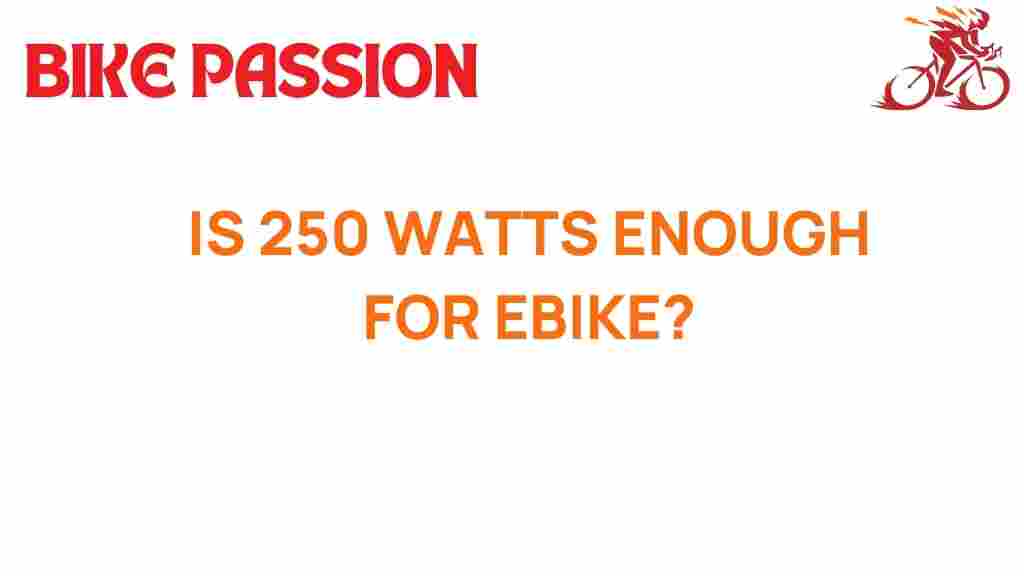Unpacking Power: Is 250 Watts Enough for Your E-Bike Journey?
The world of e-bikes is rapidly expanding, with more riders embracing electric bicycles as a practical alternative for commuting and leisure. With this growing popularity comes the crucial question: is 250 watts enough power output for your e-bike journey? This article will explore the intricacies of e-bike power, focusing on the performance, battery life, and overall efficiency of a 250-watt motor.
Understanding E-Bike Power Output
When discussing e-bikes, the term “power output” typically refers to the motor’s wattage. The wattage rating directly affects the performance of the electric bike, influencing how well it can handle various terrains, inclines, and rider weights.
Here’s a brief overview of common e-bike motor wattages:
- 250 Watts: Common in many city e-bikes, suitable for flat terrains and moderate hills.
- 500 Watts: Offers better performance for hilly areas and heavier loads.
- 750 Watts and above: Ideal for off-road cycling and steep climbs, providing significant acceleration.
How 250 Watts Affects Your Cycling Experience
With a 250-watt motor, you can expect a balanced cycling experience. Here’s what you can anticipate:
- Speed: Most e-bikes with a 250-watt motor can reach speeds of up to 20 mph (32 km/h) on flat surfaces.
- Terrain Handling: They perform well on flat terrains but may struggle with steep inclines or rough trails.
- Battery Life: Generally, a lower wattage means better battery efficiency, especially on long commutes.
Assessing the Needs of Your Commute
When considering whether a 250-watt motor is suitable for your e-bike journey, evaluate your specific commuting needs:
- Distance: If you’re commuting over long distances, a 250-watt motor may be sufficient, particularly if the terrain is relatively flat.
- Elevation: For routes with significant elevation changes, you may want to consider a higher wattage motor.
- Rider Weight: Heavier riders may find a 250-watt motor less effective, especially on inclines.
Battery Life and Efficiency
The relationship between power output and battery life is critical. A 250-watt motor is generally more efficient, allowing for longer rides on a single charge. Here are some key points:
- Battery Size: E-bikes come with various battery capacities, measured in amp-hours (Ah). A larger battery will provide a longer range.
- Range: Depending on usage, a well-maintained 250-watt e-bike can achieve ranges of 30 to 50 miles (48 to 80 km).
- Efficiency Factors: Factors such as terrain, rider weight, and assist level can significantly impact battery life.
Step-by-Step Guide to Optimize Your E-Bike Performance
To ensure that your 250-watt e-bike performs at its best, follow these steps:
- Regular Maintenance: Keep your bike in optimal condition by regularly checking tire pressure, brakes, and chain lubrication.
- Optimize Battery Usage: Use lower assist levels when cruising to conserve battery life.
- Plan Your Route: Choose routes that minimize steep climbs if you want to maximize battery efficiency.
- Monitor Weather Conditions: Wind and rain can affect performance; plan your rides accordingly.
- Adjust Your Riding Style: Pedal efficiently and maintain a steady cadence to help the motor perform better.
Troubleshooting Common Issues with 250-Watt E-Bikes
Even with proper maintenance, you may encounter issues with your e-bike. Here are common problems and their solutions:
- Reduced Power: If you notice a decrease in power output, check the battery charge and connections. A loose connection can lead to performance issues.
- Battery Not Charging: Ensure that you are using the correct charger and that the battery is properly seated in its compartment.
- Motor Overheating: If the motor gets too hot, allow it to cool down before continuing your ride. Avoid prolonged use at maximum power settings.
Comparing 250 Watts to Higher Wattage Motors
While 250 watts can be sufficient for many riders, it’s essential to understand how it compares to higher wattage options:
- Performance: Higher wattage motors (500W and above) provide better acceleration and can tackle steep hills more easily.
- Battery Drain: More powerful motors typically drain the battery faster, reducing overall range.
- Weight Considerations: Higher wattage motors are often heavier, which can affect the overall weight of the e-bike.
The Future of E-Bikes: Innovations in Power and Efficiency
The e-bike industry is continually evolving, with innovations aimed at improving power output and efficiency. Here are some trends to watch:
- Battery Technology: Advances in battery technology are leading to lighter, more efficient batteries that can provide longer ranges.
- Smart Features: Many e-bikes now come with integrated apps that monitor performance and battery life.
- Customizable Power Settings: Riders can adjust power output based on their preferences and terrain, increasing efficiency.
Conclusion: Is 250 Watts Enough for Your E-Bike Journey?
Ultimately, whether 250 watts is enough for your e-bike journey depends on your specific needs and riding conditions. For flat commutes and moderate cycling, a 250-watt motor can provide an excellent balance of performance and efficiency. However, if you frequently encounter steep hills or carry heavy loads, you may want to consider a more powerful option.
As the e-bike market continues to grow, riders are encouraged to assess their unique situations and make informed decisions based on power output, battery life, and overall efficiency. Be sure to explore various models and test ride different e-bikes before making a purchase.
For more information on e-bikes and their specifications, check out this resource for expert advice.
If you’re interested in exploring the latest innovations in e-bikes, visit this website to stay updated on the newest trends and technologies.
This article is in the category Tech and created by BikePassion Team
